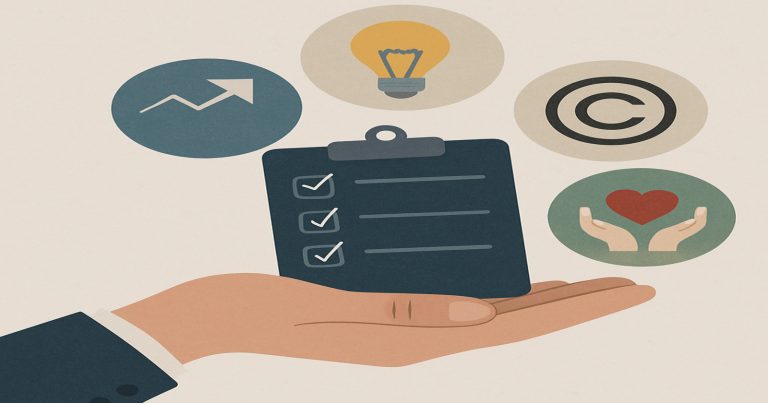Every asset in the business world today cannot be seen or touched. Some have a tremendous value and have no physical shape whatsoever. These are referred to as intangible assets. These are intangible assets like brand name, goodwill, trademark, software or patent. They help businesses grow and make money, even if you can’t physically touch them. So, what are intangible assets? Intangible assets are things a company owns that is not physical that provides future benefits. Although these assets lack a shape, they still possess value. A well-known logo or distinctive software application can be an even greater asset, even if it’s not something tangible you can put in your hand.
.
Intangible Assets Meaning in Simple Words
Intangible assets are the elements your business possesses that are valuable, but physically cannot be seen or touched. These are beneficial for the business in the long term. Assume a company makes a unique logo. This logo became well-known. People trust it. The logo is now an intangible asset, it adds value but you cannot touch it.
Other examples of intangible assets:
- Patents for inventions
- Copyrights for books or songs
- Brand names
- Software created by a company
- Customer lists
- Franchise rights
Every big company has a lot of intangible assets and you will get to know about that. Though they are intangible, they are often more valuable than machines or buildings.
Difference Between Tangible and Intangible Assets
Tangible and intangible assets are both essential for every business; however, they are, by nature, quite different. These are physical objects such as buildings, machinery, furniture, which you can see and interact with. Intangible assets, as opposed to tangible assets, refer to non-physical things such as brand names, patents, and software that retain value but are untouchable. Tangible assets can be easier to measure and sell, while intangible assets often create long-term value in the form of goodwill, rights or innovation. Having a good understanding of the difference between tangible and intangible assets is especially important for students, accountants, and business owners who are eager to make sure that company resources are being used appropriately. Both of these assets are highly valuable to businesses. But they are very different.
Tangible vs Intangible Assets
The primary distinction between tangible and intangible assets is their physical form. Ones you can touch, and ones you cannot. Both are ways of earning money, but they are treated differently on the books.
| Feature | Tangible Assets | Intangible Assets |
| Physical presence | Yes | No |
| Examples | Buildings, Machines, Vehicles | Patents, Goodwill, Trademarks |
| Depreciation | Yes | No (use amortization) |
| Seen in Balance Sheet | Yes | Yes |
| Easy to Value | Yes | No (value of such assets is tricky) |
So, the next time anyone asks you about examples of tangible and intangible assets, you know how to articulate it in layman terms.
Types of Intangible Assets
Intangible assets drive growth within a business. These assets do not exist in a physical form, but they are valuable. Each kind of intangible asset serves a distinct function. Now, let’s dive deep into each type of intangible assets with examples and simple explanations.
1. Goodwill
Intangible asset examples include goodwill. That’s the value of a company’s reputation. People would prefer when a business becomes trusted. That trust becomes goodwill.
What makes goodwill?
- Loyal customers
- Great service or products
- Strong brand image
- Trusted name in the market
Goodwill is only observable when one company acquires another. Goodwill is the premium paid in excess of the actual worth of assets. This is the reason that goodwill is an intangible asset, even though you cannot see it.
2. Trademarks
Trademarks are names, words, logos, symbols or taglines. These assist people in recognizing a company’s brand. They help differentiate products and services.
Examples of trademarks:
- The “TATA” logo
- Nike’s “Swoosh”
- McDonald’s yellow “M”
If it is copied by another company, the original company can sue the other one. So a trademark is an intangible asset that provides legal authority to a brand.
3. Patents
A patent grants a company the ability to prevent others from duplicating an invention. If a company creates something new and unique, it can get a patent.
What patents protect?
- Machines
- Software tools
- Medicine formulas
Typically, a patent is valid for 20 years. After that, the idea is open for anyone’s use. An owner has complete rights until then. Which is why patents are incredibly valuable.
4. Copyrights
Copyright law protects original expressions. These can be books, music, films, software, and artwork. The creator receives credit and compensation from others who use the work.
Copyrights help:
- Authors
- Artists
- Musicians
- Software developers
In India, a copyright lasts for the life of the creator plus 60 years. This means the creator (or family) gets income from it for a long time.
5. Franchise Rights
A business giving another individual or group the right to use its name, brand or method. The buyer receives an off-the-shelf success model.
Example:
Domino’s gives franchises. Anyone who purchases one will be able to sell pizza under the Domino’s name. You get the method, training, and setup. Franchise right is an intangible asset. It provides value in intangible form.
6. Licenses and Permits
At times, you need a license to do business. A telecom company, for instance, must obtain a government license. Licenses are not just rights, they are legal rights.
Common licenses:
- Broadcasting licenses
- Mining rights
- Software usage licenses
If the license lasts for several years and brings in profits, it becomes an intangible asset. It needs to reflect this in the balance sheet of a business.
7. Customer Lists
Customer data is extremely valuable in many businesses. Contact names, contact details and purchase records lead to company growth. Lists like these can be purchased and sold like any commodity.
What makes customer lists an asset?
- Help in targeted marketing
- Increase sales
- Save time and money
This is also associated with customer loyalty. So customer lists are valuable intangible assets in marketing-heavy industries.
8. Computer Software
That company’s software now becomes an intangible asset. This is the case when the software is specific and is not purchased from a store.
Examples:
- Bank develops software to be used in managing loans
- A company develops a billing app for internal use
This is not like purchasing MS Excel. Software that is built adds future value to that business, and as such, accountants treat it is as an asset as opposed to an expense.
9. Research and Development (R&D)
A business will use the term research and development if it invests money into potential new products or improving current products. Occasionally, the outcome becomes an asset.
R&D becomes an asset if:
- It gives future income
- It is clear and measurable
- It complies with the guidelines of AS 26 intangible assets
Pharma and tech companies, in particular, have most of their value tied up in R&D.
Amortization of Intangible Assets
Intangible assets depreciate just like machines do. But this process is amortization, not depreciation. It should be noted that amortization of intangible assets makes clear the scenario of the company’s profitability.
How Amortization Works?
Intangible assets depreciation rate varies according to each asset type as well as its lifetime. Amortization is presented in the profit and loss account. It accrues as a cost much like depreciation.
- Businesses do amortize the value of intangibles incrementally each year.
- This is done throughout the asset’s useful life.
But if software has a 5-year lifespan, the cost is amortized over 5 years.
Valuation of Intangible Assets
It is hard to assign value to an intangible asset because it is not tangible. But you have to know their value, very important when making business deals and working through balance sheets. It contributes to mergers and partnerships, as well as financial planning. Valuation of Intangible assets reveals actual value and enables smarter decision making. Determining the value of an intangible asset is hard. But it needs to be done for balance sheets, mergers or selling off businesses.
Methods for Valuation of Intangible Assets
Valuation of the intangible assets could be done in numerous ways. The determination is related to the way in which the asset is visually represented and how it generates revenue. These techniques enable firms to accurately record and price their assets. There are three main methods:
- Cost Method – Actual cost of creating the asset.
- Market Method – Based on what other parties pay for identical assets.
- Income Approach – What future income the asset will generate.
To do so, take for example to evaluate a patent, calculate how much money this will generate in the future. This gives a fair value. This is the approach that is used for valuation of intangible assets in company audits or sales.
Accounting Standard AS 26 Intangible Assets
When accountants of India record these in books then they follow AS 26 intangible assets. Accounting Standard AS 26 specifies the manner of accounting for, evaluating, and preparing financial records involving intangible assets. It establishes guidelines for calling an asset intangible and how to handle its cost through time. AS 26 lays down similar road maps for companies in India dealing with software, trademarks, goodwill and other non-physical assets. This standard helps bring clarity, fairness, and transparency to accounting practices associated with intangible assets.
What AS 26 Says?
All companies in India should comply with AS 26 intangible assets. It aids in making accounting equitable and transparent.
- It describes how to recognize intangible assets.
- It defines how their useful life is tested.
- It describes how to amortize them.
- It provides guidelines for disclosure in balance sheet.
Intangible Assets: Real Examples and Use in Business
Knowledge required to help users understand intangible assets examples. Today, in our digital and service economy, intangible assets are a significant determinant of business success. These may not be visible assets, but they contribute enormous value to a company’s brand, growth and profits. Studying intangible assets examples from actual- life companies can help us understand how they function and why they are important. Such non-physical asset examples demonstrate how trust, customer acquisition, and long-term business value is generated through non-physical assets.
Real Examples
These assets assist these businesses to stay ahead. They may be invisible, but they are powerful business tools. Many people wonder, “Is an intangible asset any good if it can’t be sold? The answer is yes. While some are intangible assets and do not have realizable value, they protect long-term success.
- Software IPs belong to Infosys – intangible.
- Amul has an iconic logo, non-possessive.
- Zomato has own customer data — intangible.
- It is intangible, but Tata has goodwill.
Why Intangible Assets Matter in Modern Business?
Most of business value is intangible. Today, businesses have greater revenue from ideas, brands and technology than from buildings or machines. That is why intangible assets are more precious than ever. They fuel growth, trust, and sustainable success.
Importance in Indian Market
Intangible assets are now a bigger part of Indian startups, IT companies, and brands. Why?
- Brand value is what leads to customer trust and customer loyalty.
- Technology like online tools and software makes running a business easier.
- Stand out with unique logos and designs.
A startup doesn’t even need to own a building, its intellectual property alone can be worth millions.
Relevance to ACCA Syllabus
Regarding ACCA, intangible assets are at the heart of Financial Reporting (FR) and Strategic Business Further Information (SBR) in relation to IAS 38. The students are required to know about the recognition, measurement, amortization, impairment, and disclosure of intangibles.
Intangible Assets ACCA Questions
Q1: What is the IFRS standard on accounting for intangible assets?
a) IAS 16
b) IAS 38
c) IFRS 15
d) IAS 21
Answer: b) IAS 38
Q2: When does an internally generated brand be acknowledged as intangible asset according to IAS 38?
a) Always
b) Never
c) Only if it is a money maker
d) When legally registered
Answer: b) Never
Q3: According to IAS 38, what should development costs be treated as?
a) Expensed as incurred
b) Capitalized if criterion is met
c) Recorded as goodwill
d) Written off to reserves
Ans: b) Capitalized if criteria met
Q4: Intangible assets that have indefinite useful lives are accounted for differently than other assets.
a) Amortized over 10 years
b) Not amortized; tested for impairment annually
c) Written off immediately
d) Depreciated like PPE
Answer: b) Not amortized, but tested for impairment annually
Q5: Which one of the following is not an intangible asset under IAS 38?
a) Trademark
b) Patent
c) Importantly internally created goodwill
d) Franchise license
Answer: c) Internally generated goodwill
Relevance to US CMA Syllabus
Intangible assets are a key topic that is covered in Part 1: Financial Planning, Performance, and Analytics of the CMA exam. Candidates should evaluate the recognition of, and criteria for recognizing, assets, together with an understanding of their measurement, impairment, and amortization, particularly for decision-making and performance management purposes.
Intangible Assets US CMA Questions
Q1: Intangible assets with a defined life are recorded per US GAAP as
a) Depreciation
b) Revaluation
c) Amortization
d) Immediate expensing
Answer: c) Amortization
Q2: Which of the following is an indefinite-lived intangible asset?
a) License with 5-year term
b) Copyright
c) Goodwill
d) Patent
Answer: c) Goodwill
Q3: When should a company test tangible assets for impairment?
a) Only at year-end
b) If there is an indication for impairment
c) Every quarter
d) Never
Answer: b) If there is an indication of impairment
Q4: Intangible assets are recognized at fair value in a business combination at what cost?
a) Historical cost
b) Market-to-book ratio
c) Fair value
d) Net realizable value
Answer: c) Fair value
Q5: What are development costs as per US GAAP?
a) Capitalized
b) Expensed as incurred
c) Treated as goodwill
d) Added to inventor
Answer: b) Expensed as incurred
Relevance to US CPA Syllabus
Intangible Assets is a significant topic area under FAR (Financial Accounting and Reporting). CPA candidates must apply U.S. GAAP guidance for asset recognition, amortization, impairment testing and financial statement presentation.
Intangible Assets US CPA Questions
Q1: Item from the list below which is recognized as an intangible asset under U.S. GAAP is:
a) Goodwill that was generated internally
b) Customer list acquired in purchase
c) Advertising expense
d) Employee training cost
Ans: b) Customer list purchased during acquisition
Q2: Goodwill impairment testing under U.S. GAAP must be conducted:
a) Monthly
b) Once a year or when triggering events occur
c) Never
d) After every sale
Answer: b) Annually or when triggering events occur
Q3: Which of the following statements is TRUE?
a) Take goodwill amortized over 10 years
b) Costs of research are capitalized
c) Intangible assets are reassessed annually
d) Charged to expenditure, only development costs can be capitalized
Answer: d) Only development costs may be capitalized
Q4: What is the general accounting treatment from the U.S. GAAP perspective for a purchased trademark?
a) Amortized over 5 years
b) Expensed immediately
c) Incurred and tested for capitalized impairment
d) Revalued to market price
Answer: c) Capitalized, and tested for impairment
Q5: What test is used to test indefinite-lived intangible assets for impairment?
a) Recoverability test
b) Two-step impairment test
c) Fair value test
d) Present value test
Answer: c) Fair value test
Relevance to CFA Syllabus
Intangible assets are covered in Level I and Level II under Financial Reporting and Analysis in CFA. Candidates need to analyze recognition & measurement, impact on financial ratios and the effects of intangible assets on valuation.
Intangible Assets CFA Questions
Q1: What is the impact of intangible assets on ROA?
a) They add income as well assets
b) They reduce the denominator increasing ROA
c) They only increase the numerator
d) They do not fall under ROA
Answer: a) They raise both income and assets
Q2: Internally generated research costs are:
a) Always capitalized
b) Always expensed
c) Partly amortized
d) Treated as goodwill
Answer: b) Always expensed
Q3: Why is it challenging to make comparability on intangible assets on a company-to-company basis?
a) They are always revalued
b) They lead a hypocritical life
c) Sets of accounting policies are applied
d) They do not have legal directives
Answer: c) Different accounting policies are applied
Q4: The impact of capitalization of intangible assets on EBITDA is-
a) It reduces EBITDA
b) It has no effect
c) It increases EBITDA
d) It reduces net income
Answer: c) It positively impacts EBITDA
Q5: Which intangible asset can be revalued under IFRS but is not allowed under US GAAP?
a) Goodwill
b) Patents
c) Trademarks
d) All identifiable intangibles
ANSWER: d) All identifiable intangibles


